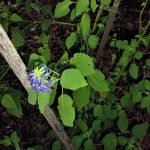Salvia densiflora: is a tall upright shrub, 2-3mH with small numerous dense heads of blue flowers in autumn and winter.

Salvia densiflora: is a bushy upright shrub.
Flowers: are a dark sky blue, semi tubular with a pale tube and a small pale hood. All anthers and the stigma are well exerted. the 2 side lobes are small, often tucked behind the main middle lobe. This is much longer than the hood with an expanded frill that is slightly split.
This exerted lobe acts as a landing place for bees and pollinating insects. A pale area along the centre, being the beeline, guides the insects further into the flower where the exerted anthers and stigma brush against their body.
Flowers are held in tight whorls of 4 flowers in dense compact heads at the end of long stems, held above foliage to attract passing insects.
Most flowers appear from autumn, continue into winter and early spring.
Calyces: are small, green, slightly ribbed with pointed lobes. Once the flowers have finished, most calyces remain within the dense head. This eventually shrivels, but remains on the stem.
Leaves: are bright green, broad cordate, well textured, well veined with small crenations along the margins. Most stems are well clothed.
Salvia densiflora: is an interesting shrub to have in the garden, plant at the back of a small bed or in the middle of a larger bed. Plant either in dappled shade or a sunny protected position, among other shrubs that will give protection protection from frost.
Grow with other pink, crimson, red or white tall or medium size shrubs. Although frost tender, it is generally cold hardy, tolerating the hot dry summer season fairly well, but would appreciate any supplementary watering.
When the main flowering period has finished in winter, new basal growth appears, which indicates when to remove the old stems. Cut away any dead or twiggy growth, leaving all new stems, which should quickly grow to full height during the spring and summer months. When trimmed, feed and mulch well to keep the root area cool during the hot dry summer season.
Propagation: usually by tip cuttings taken at any time of year.
Note: Not readily available. Orders to be taken


